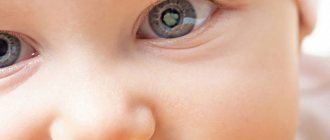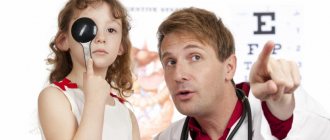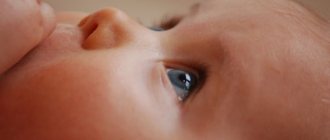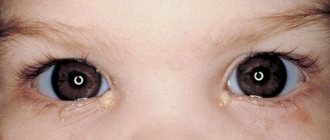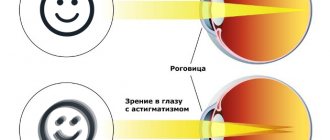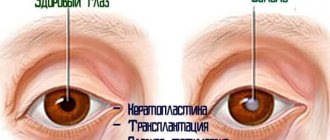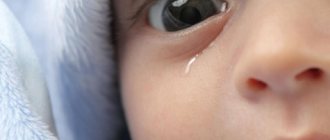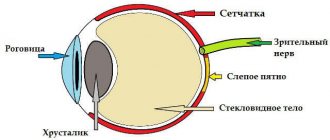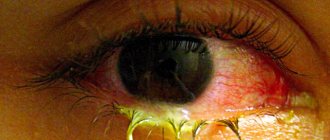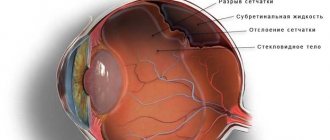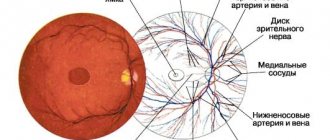Loss of vision in adolescents is a big problem for the children themselves and their parents. The most common vision problems at school age are progressive myopia or myopia. School myopia usually begins at the age of 10-12 years, sometimes earlier, and progresses as the child grows older.
The progression of myopia occurs due to the growth of the eyeball, that is, an increase in the length of the eye. Growth of the eyeball can be observed up to 20-22 years. and during this period, in addition to decreased vision, changes occur in the structure of the eye and, in some cases, dystrophic changes appear in the fundus.
In addition to myopia, vision at school age can be affected by astigmatism and farsightedness (or hyperopia).
Farsightedness and astigmatism not only reduce vision, but also cause the development of asthenopic syndrome or eye fatigue, which affects the child’s performance at school.
Features of vision in children
First you need to know that the visual system of children is different from the vision of adults. When a newly born baby looks at mom and dad, you shouldn’t console yourself with the thought that he has already remembered his own faces. A child is born with an immature visual system and sees much worse than adults: not once or twice, but twenty to thirty times.
Even for a healthy, full-term baby, infant hyperopia (farsightedness) is the norm. Throughout the first month of life, infants see only large objects at a distance, and even then indistinctly, with blurred contours. The perception of colors is also still developing; at first, the world appears predominantly in whitish-gray tones. According to various experts and depending on the individual growth rate of the child, such vision lasts from one month to six months.
This is due to the shape of the eyeball: in young children it is small in size and flat in shape, which creates farsightedness, which can reach three diopters normally and gradually decrease as the child grows. From one and a half to three years, farsightedness can normally be up to + 1.5 - 2.0 diopters. Ophthalmologists also call it “reserve”. This small plus no longer prevents the child from actively exploring the world, playing, communicating, and developing. By the age of 5-7 years, a child’s vision approaches the adult norm. But the visual system continues to develop until adulthood, which is why, for example, laser vision correction operations are recommended to be performed no earlier than 18 years. Until this age, the refraction of the eye can still change on its own.
Visual impairment in schoolchildren
Myopia is a variant of vision impairment in which the eye sees objects located in close proximity (up to the so-called distant point of view). Objects located further away are no longer in focus and are not clearly visualized:
The following types of myopia are distinguished:
- Axial - manifests itself in the fact that the eyeball is too long, and the image is formed in front of the retina, and not on the retina. Thus, the image becomes blurry. Elongation of the eyeball by 1 mm (relative to normal length) means that myopia increases by -3.00D.
- Refractive – when the surface of the cornea is steeper compared to standard parameters.
- Mixed - when both of the above parameters are observed in one eye: the length of the eye and the curvature of the cornea exceed normal values.
Farsightedness is a type of visual impairment in which vision is reduced not only in the distance, but also near. With weak degrees it may not cause vision problems and does not require correction.
Farsightedness options
- Axial - when the anteroposterior size of the eyeball is shorter than standard. Thus, the focus is formed behind the retina.
- Refractive - when the cornea has a flat profile and weak refraction.
- Mixed - when the above symptoms are combined in one eye.
Astigmatism is another reason for decreased vision, in which there is no single focus in the eye and a light scattering corridor is formed, which leads to a decrease in the quality of vision, double vision, blurry images, etc. There is a distinction between regular and irregular astigmatism.
- Correct, due to the shape of the cornea and is usually present from birth, but does not always cause vision impairment from childhood.
- Incorrect, due to a change in the profile of the cornea or lens due to trauma, penetrating wounds or other eye interventions. It is of an acquired nature.
The main thing to remember is that any of the above refractive errors can lead to visual impairment both in childhood and adolescence. Therefore, it is important to consult an ophthalmologist from early childhood.
After birth, changes gradually occur in the eyeball, one of which is a process called emmetropization. The eyes gradually grow to regularity - emmetropia, i.e. their size and have such parameters of the entire optical system that the visual focus is formed in the central zone of the retina, thereby forming good contrast vision. If any of the eye parameters are changed, the image will be distorted or unclear. The image will be out of focus and the eye will have to work harder to see more clearly. Over time, as vision loss progresses, the eye cannot cope with the task and vision steadily decreases. In this case, it is no longer possible to do without correction means such as glasses or contact lenses.
Most often, during school and adolescence, vision decreases due to the progression of myopia, since during this period there is active growth of the eyeball. In order not to lead to myopia in a child or to slow down its progression, it is necessary that the length of the eyes does not increase.
So what causes the eyeball to grow faster? Scientists' opinions are divided:
- Unregulated visual load;
- The dominant mechanical influence of convergence generated by accommodation;
- Hereditary factor;
- Weakness of connective tissue.
Eye diseases in preschool children
Visual acuity impairments in young children are most often due to hereditary causes or are a consequence of pathology in the intrauterine development of the fetus. Even with undeveloped vision, gross pathologies are detected by doctors already in the first or second month of life. This may be congenital glaucoma (a disease of the visual system, accompanied by increased intraocular pressure and atrophy of the optic nerve), cataracts, strabismus, nystagmus of the eyeball - frequent involuntary blinking, indicating neurological disorders.
A little later, at 3-5 years, hereditary myopia or farsightedness may appear. At this age, as a rule, the child’s vision is not yet exposed to school stress and, if long-term computer games are excluded, then the root cause of deterioration in the child’s vision is most likely attributed to eye diseases in the family of immediate relatives.
Diseases of the endocrine, cardiovascular, and nervous systems can affect the condition of the organ of vision. In this case, the deterioration of vision is secondary in nature and the root cause should be treated first.
School as a risk factor
School years are not only wonderful, but also dangerous, and primarily for the student’s vision. The child’s life changes dramatically, which becomes a serious stress primarily for two systems of the body - nervous and visual. If the nervous system comes under the influence of psycho-emotional stress, then the visual system experiences increased physical stress on the eye muscles. Let's add to the work in the classroom the mandatory extracurricular cognitive activities provided for by the school curriculum, doing homework every night and a passion for computer games and gadgets, for which the child always has time, even secretly during recess.
Modern schoolchildren sometimes have more eye strain than their parents. Is it any wonder that children easily get their first visual “minus” in elementary school.
How to preserve a schoolchild's vision
Treatment of visual impairments consists of correct and timely diagnosis and treatment of the disease that caused them. It is imperative to visit an ophthalmologist, identify whether there are any problems with vision, assess the condition of the eye, identify the cause of visual impairment, and in some cases there is a need for examination by related specialists.
If refractive errors are detected, adequate correction is required with glasses, soft contact lenses or night lenses. In order to stop the progression of myopia, prevent the development of strabismus and amblyopia.
In some cases, therapeutic treatment is required, which includes drug therapy (for example: drops, injections, vitamins, etc.). pleoptic and orthoptic treatment using simulators and, in extreme cases, surgical treatment.
Symptoms of visual impairment in children
In young children, the first alarm bells are
:
- A long unblinking gaze at one point
- Frequent, unsystematic and causeless blinking
- Increased tear production not associated with the baby's crying
- Lack of visual response to voice and color stimuli.
An attentive parent will immediately notice that something is wrong and consult a doctor without waiting for a routine examination by an ophthalmologist.
Children of preschool and school age also cannot always immediately recognize and inform their parents about the emerging visual discomfort. The warning signs are
:
- Increased fatigue
- Redness of the eyeball
- Complaints of headaches
- Sleep disturbance
- The habit of squinting your eyes when looking at objects in the distance.
An indirect sign of visual impairment may be problems with studies, absent-mindedness, or capriciousness of the child. Vision is our connecting link and guide in the world around us. When it gets worse, a person immediately leaves his comfort zone and problems appear from all sides. The task of parents is to notice changes in the child’s condition in a timely manner and, with the help of specialists, establish the exact cause.
Preventive examinations are not for show
A key place in the prevention of vision deterioration in children should be given to regular and comprehensive vision examinations. Precisely regular and precisely complete – not for show.
It would seem that everything is so simple and obvious! But, as practice shows, not at all. Often, parents, after routine examinations by an ophthalmologist at a child’s early age (3 months, 1, 2, 3 years), making sure that everything is fine with his vision, calm down and then let the examination by the ophthalmologist take its course. Moreover, if a child attends a preschool institution, examinations are often carried out at the kindergarten by a doctor coming from the clinic, including a routine examination for 1st grade when filling out the student’s medical card. Simple and convenient for parents.
Agree, there is a difference between examining children on stream in conditions that are not always suitable for this and visiting a diagnostic room equipped with advanced computer technology in a specialized clinic. Dear parents, we would like to remind you once again: do not neglect your responsibilities and take your child for an eye examination to an ophthalmologist yourself, at least once a year, and more often if indicated.
Take care of your eyesight from a young age
The classic advised to take care of honor from a young age, and ophthalmologists can add – and vision! Among the simplest and most effective preventive measures, parents should remember the need to:
- Enough walking - not only the lungs need oxygen
- A complete, balanced diet - lack of nutrients, macro- and microelements leads to malnutrition of the optic nerve
- Good illumination with natural and electric light in the children's room
- Proper organization of the student’s workplace
- Control over the child's daily routine.
Particular attention should be paid to the time the child spends with electronic devices. It is best to strictly regulate the duration of computer games and communication on social networks, and use the phone for its intended purpose - for calls, and not for games in any free minute.
Don’t forget about eye exercises: it is a mistake to think that it is only indicated for those who have already been diagnosed with vision impairment. A series of simple exercises with circular movements of the eye clockwise and counterclockwise, shifting the gaze from distant objects to near ones and back, tilting the head will help relieve accumulated visual tension, improve blood circulation and nutrition of the optic nerve. Having become a habit, eye gymnastics will help the child maintain vision during school stress, and the specialists of the eye center, Professor E.I. Belikova will always help you with advice and conduct a full diagnosis of the child’s vision quality on the day of your visit. In the initial stages of myopia or farsightedness, a good therapeutic effect is achieved by courses of hardware treatment, which your child can undergo in our clinic.
How to recognize myopia in a child?
In many cases, childhood myopia is believed to be treatable. The fundamental factor is early diagnosis of pathology. In order not to trigger the development of myopia in a child and not to think about how to treat myopia in the future, you should regularly examine the condition of the visual organs by an ophthalmologist. In the absence of previously diagnosed problems, adults are recommended to visit a doctor at least once every two years. Children need to be examined more often - at least once every 12 months. The first signs of myopia in children are rapid visual fatigue during reading, drawing and other activities. Some children complain of frequent headaches, become irritable and withdrawn, and perseverance suffers. Sometimes babies rub their eyes, which can cause infection and the appearance of a number of diseases: conjunctivitis, stye and others. It is difficult to detect myopia in children at an early stage. This is due to the fact that initially the child does not have problems with vision, since he sees quite well both near and far.
Classes for visually impaired children
In medical theory, there is a special classification for children with vision problems. It takes into account whether the child is able to see a couple of bright dots or not, how many lines he clearly distinguishes in the test table. If a child does not see line 10, 9, 8, and so on, we can talk about myopia.
Classifier of children with vision problems:
- Visually impaired - impairment of visual acuity is in the range of 0.05-0.2. Patients in this group normally perceive information from the outside;
- Blind - the development of vision is stopped, there is no figurative perception of information, although in some cases there are residual signs of vision. Training – at home or in compensatory institutions;
- Partially blind people have the ability to form images and discern light. Deviation range 0.005-0.4;
- Blindness – visual images are completely absent. Training is strictly individual;
- Blind children may be blind at birth, or the loss of vision may occur gradually. In the second case, visual function stops developing at the age of 6 years.
Patient Features
Children with visual impairments, especially severe ones, are dependent on teachers and parents.
They are also very different from healthy children in psychological reactions and behavioral factors:
- Incorrect coordination of movements, which is especially clearly manifested during active games, movements are uncertain, there are “drifts”;
- Gestures and facial actions are very limited, sometimes completely absent, although they should normally be present;
- Excessive or delayed development of speech (at first it is usually slow, and then sharply accelerates).
It takes more time to examine a child with vision problems than a healthy one, since such patients are slow to concentrate, think about movements and actions for a long time, and seek approval for actions. Due to such psychological characteristics, in case of significant impairment of visual function, training in specialized institutions is recommended.
A child has myopia: what to do?
There are several effective ways to combat myopia: optical, laser, drug and surgical correction. As a rule, radical methods of treating myopia are not used in childhood. This is due to the child’s underdeveloped eye system. Children with myopia cannot undergo laser vision correction. It is believed that complications may occur. In addition, the procedure will not bring positive results or will not stop the further development of the pathology (that is, there will be a temporary, but not permanent improvement). If a child begins to complain of deteriorating vision, it is necessary to contact an ophthalmologist, who will determine the extent to which myopia is developing and adjust the parents’ further actions.
Conjunctivitis
The essence and reasons. The disease can be caused by a viral or bacterial infection, as well as allergies.
Symptoms. The eyes turn red, the eyelids swell and itch, and purulent or profuse clear discharge appears from the eyes.
Treatment. Rinsing the eyes with anti-inflammatory solutions (chamomile decoction, for example). To treat bacterial conjunctivitis, use topical antibiotics in the form of eye drops or ointments. For allergic conjunctivitis - antihistamine drops.
Show me your eyes! Why you shouldn’t hesitate to visit an ophthalmologist
More details
"Lazy Eye"
The essence and reasons. It occurs in approximately 2% of children and is often a consequence of strabismus. With this problem, one eye sees worse than the other, and the brain blocks this unclear picture. Therefore, children with amblyopia do not have normal binocular vision. This not only narrows the view, but also does not allow one to assess the depth of the image, so the world seems flat to such children. Over time, vision can decrease not only in the “weak” eye, but also in the “strong” eye, up to complete blindness.
Symptoms. The child sees poorly in one or both eyes, and sometimes squints. He may also tilt his head to the side or close one eye when reading, watching TV, or simply looking at an object.
Article on the topic
The price of progress. The number of children with poor vision is growing in Russia
Treatment. If treatment is started before the age of 7, when the formation of the visual system is completed, the disorder can be corrected with the help of eye drops, glasses, surgery, or taping the “strong” eye. If conservative treatment does not help, surgery is performed.
